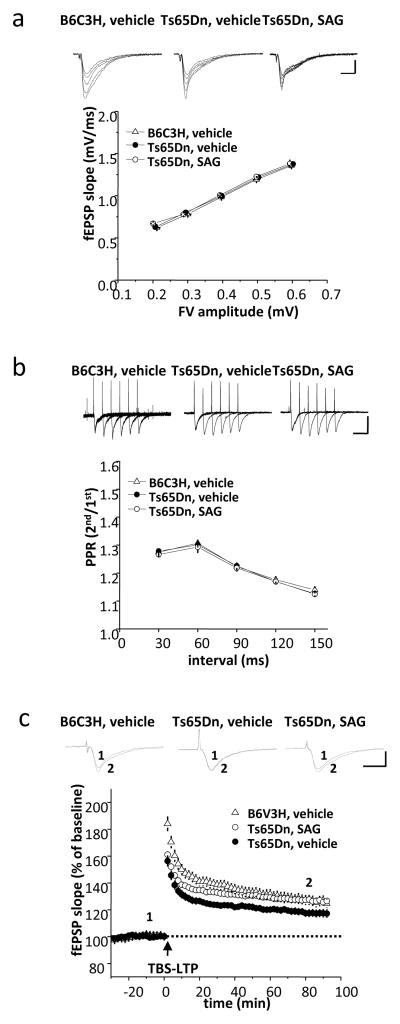Fig. 4.
SAG rescues attenuated TBS-LTP in hippocampal slices from Ts65Dn mice. a) Relationship between fiber volley (FV) amplitude and fEPSP slope of the Schaffer collateral-CA1 synapses in slices from euploid and Ts65Dn mice (10- to 12-week-old males). Each point represents the mean ± SEM for a narrow range of fiber volley amplitudes and fEPSP slopes. (EuVeh slices, n=14; TsVeh slices, n=24; TsSAG slices, n=9). Scale bars: 1 mV, 10 ms. b) Representative traces in response to paired pulses in hippocampal slices derived from euploid and Ts65Dn mice (10- to 12-week-old males). Each plot point shows the mean ± SEM of the PPR (EuVeh slices, n=14; TsVeh slices, n=18; TsSAG slices, n=11). Baseline synaptic properties, including the fiber volley-fEPSP relationship and paired-pulse facilitation ratio (PPR) were normal in both TsVeh and TsSAG mice. Scale bars: 1 mV, 50 ms. c) SAG significantly enhanced TBS-LTP in slices from Ts65Dn mice. LTP was induced by theta burst stimulation (TBS: 5 bursts delivered at 5 Hz; each burst consisted of four stimuli at 100 Hz). TBS-induced LTP was significantly reduced in TsVeh (n=15) compared to either EuVeh (n=12) or TsSAG (n=19). (TsVeh vs. EuVeh slices, p=0.001 at t=30 min., p=0.038 at t=80 min.; TsVeh vs. TsSAG slices, p=0.006 at t=30 min., p=0.005 at t=80 min.; EuVeh vs. TsSAG slices, p=0.147 at 30min, p=0.97 at t=80min, compared to EuVeh slices by unpaired two-tailed Student’s test). Scale bars: 1 mV, 50 ms.

